A New Ongoing Project: The Satomi/Sammy/Three Star Arrangeball!
“Oh, what’d you get there? A new pachinko machine?” “It’s technically not a pachinko machine, though it does use pachinko balls, and a pachinko launcher…” “So it’s a new pachinko machine.” Such is the conversation between myself and my fiancee. What is this new machine? What have I gotten myself into? Is this the beginning of the analog age of Nicole Express? One thing’s for sure: it may be new to me, but it’s definitely not new.
What is pachinko, anyway?
Behold: the Satomi/Sammy/Three Star Arrangeball. It really does look like a pachinko machine, doesn’t it?
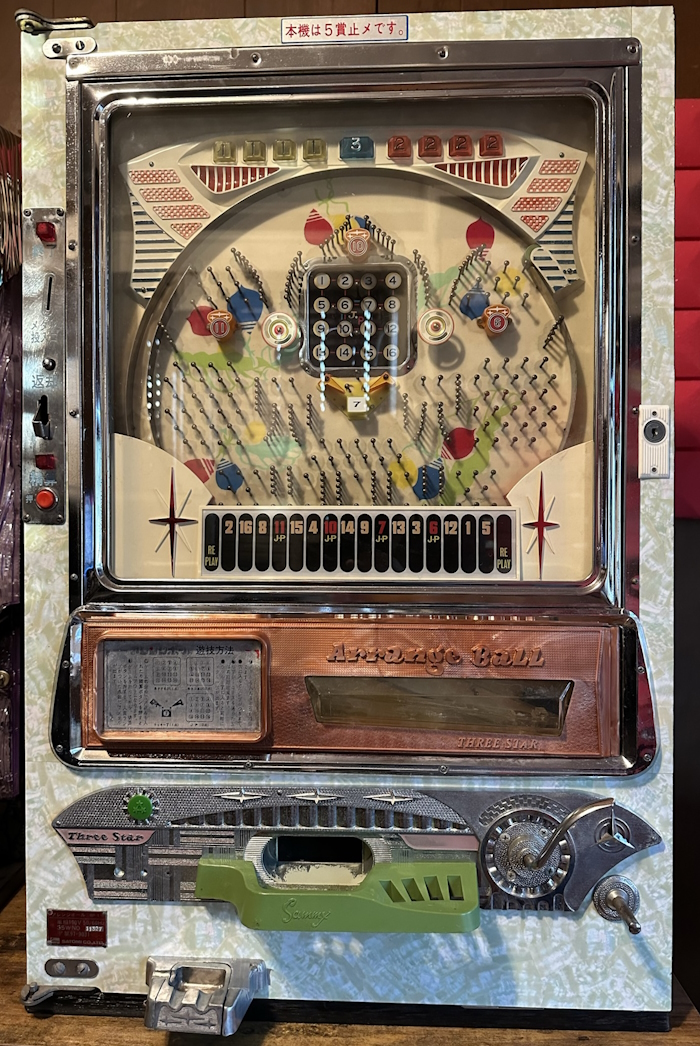
But look closer. On a pachinko machine of the era, like my Nishijin Power Flash Thunderbird you’d see an open tray here, where you’d put the metal balls that you leased from the parlor. Your winnings would also flow into this tray, as the Thunderbird is an “auto-loader”. But what’s on the Arrangeball?
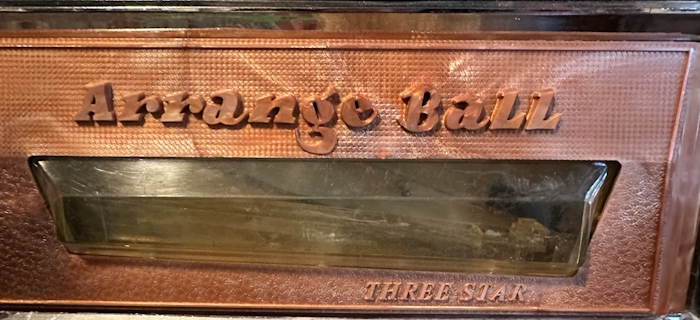
A closed compartment. This machine is, like a modern “sumapachi”, fully “recirculating”. The balls that you play simply recirculate within the machine. But unlike sumapachi, the game you play is not the same as pachinko. Take a look at the playfield.
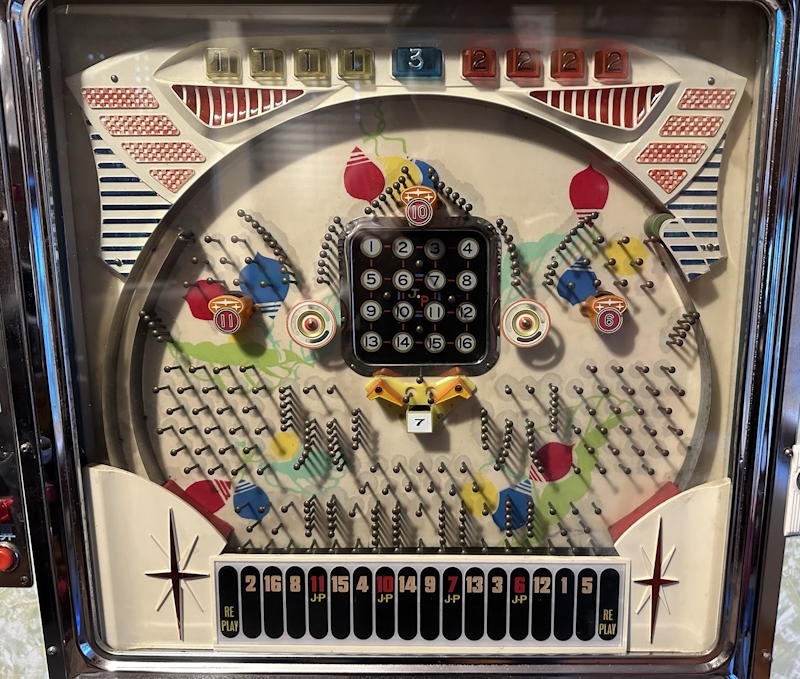
Sure, there are pins that direct the ball in unpredictable ways, like a pachinko. But notice all the numbered pockets. When a ball goes into a numbered pocket, it lights up a circle on the grid in the center.
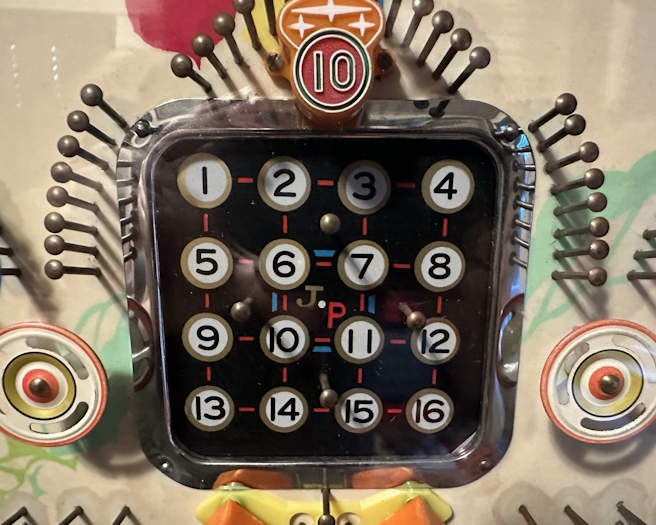
Those of you up on your pinball history may have figured it out already: she’s a bingo!
Well, not quite– as far as I can tell, this is an independent development with no connection to the bingos. Here’s how a game of arrangeball on this machine should work:
- You insert a “medal”, which looks like a coin but is not legal tender, into the machine.
- You receive sixteen balls in the loading compartment.
- Fire the balls onto the playfield.
- If they fall into the outer pockets, they go back into the loading compartment to be fired again.
- If they land in a pocket, that pocket lights up. Unlike bingos, multiple balls can land in the same pocket, however.
- You win points based off forming lines or patterns on the game grid according to the rules. The numbered lights at the top of the board light up.
- Getting a ball in the “7” pocket below the grid will give you a medal immediately. This only applies to the one directly below the grid, not the 7 slot in the bottom of the playfield.
- Press a button and your points are converted into medals, which are paid out into the green pocket.
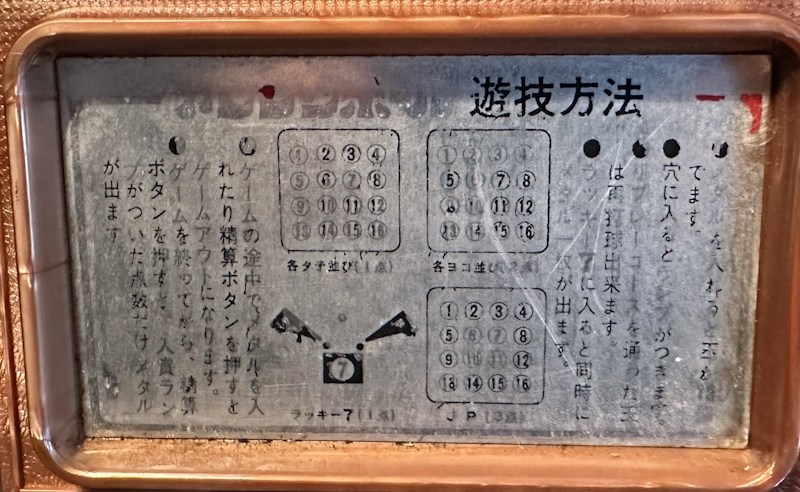
The heyday of arrangeballs seems to end around 1980-1981, but medal games are still popular in Japan and elsewhere. As far as I know, except for pachislo, a slot machine variant often available at pachinko parlors, modern medal games are not involved in the same sorts of technically-not-gambling. The 1970s? Eh who knows.
Why is this a project?
So, I sent this machine to Dan Welch of Magic Pachinko Restorations. But he wasn’t able to give it the full working treatment that he was my Power Flash. These machines are just not very common in the United States, so the replacement parts aren’t around. And unfortunately, my machine has some issues.
The biggest is that it doesn’t pay out. You can start a game (most of the time), get your sixteen balls, fire them, light up the grid and light up the numbers at the top, but pressing the button to end the game does nothing.
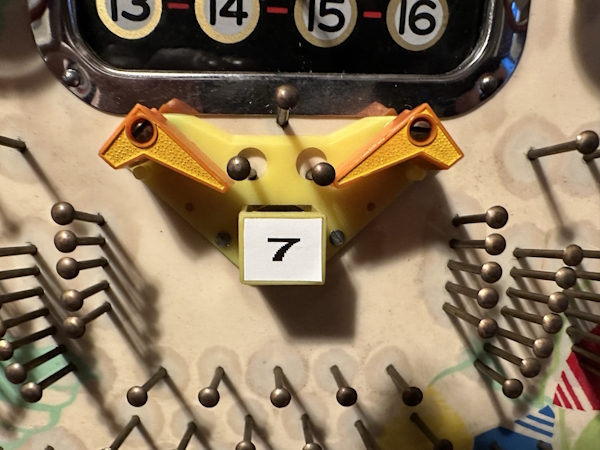
Remember that seven pocket, though? It does pay out. Which narrows down the issue: instead of being a broken payout mechanism, it just means that the end-of-game “search” mechanism that counts your score up is broken! That’s… probably not better.
Let’s open up the machine.
Folding
The front of the machine opens up entirely; I don’t have a key, but there’s a latch I can reach though one of the handholds on the side. The wood is very rough on this machine; I feel like I’m going to get a splinter every time I touch it.
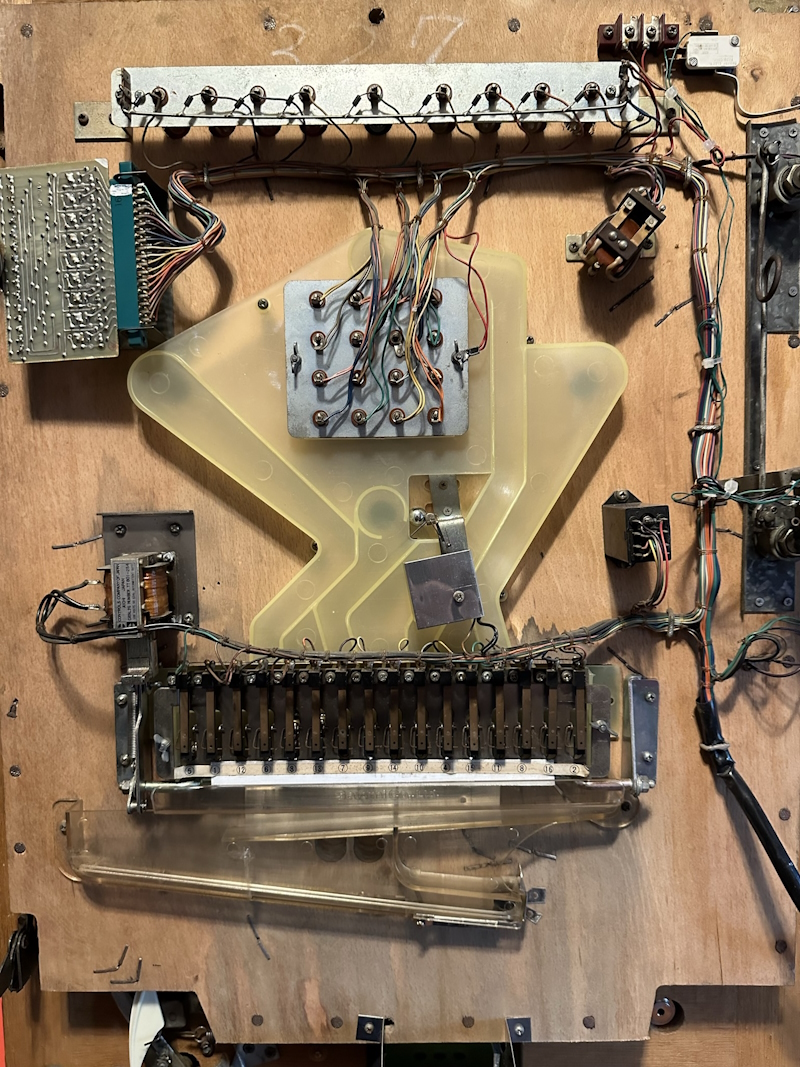
This machine appears to be an earlier one; there are pretty much no ICs to be seen. Which is kind of annoying, as I like ICs.
The front pockets are all connected each to their own leaf switch which lights up the pocket. You can also see a second switch hooked up that connects to that seven pocket I mentioned; the other pockets on the playfield just direct balls to where they go. A solenoid holds a metal bar, stopping the balls in the pockets from being dropped.
On the other side, things are simpler. Seriously, the door is much heavier than the rest of the machine, so it’s very unsteady when opened.
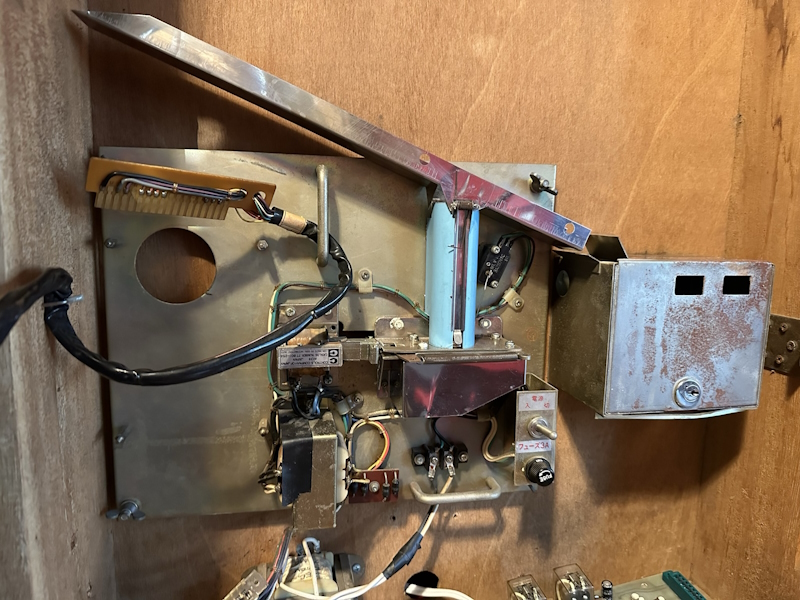
Coins Medals go into a ramp. There’s a small stack for paying out winnings; any medals beyond that go into the bin. I don’t own nearly enough medals to get close to going into the bin.
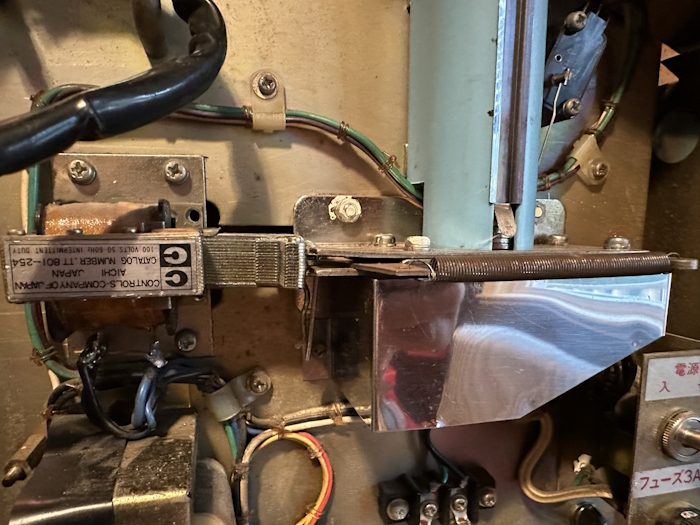
This is the payout mechanism. The solenoid pulls open with a fairly strong pull, and a coin is ejected. Most of the time. It’s not as reliable as I’d like, and it’s very intimidatingly loud. I guess they wanted it to be a satisfying win.
You might have noticed that there are a bunch of loose connectors. Those of you more familiar might be thinking that Nicole has purchased a true lemon, missing a major component. But actually, the board that was there I do have, I just removed it.
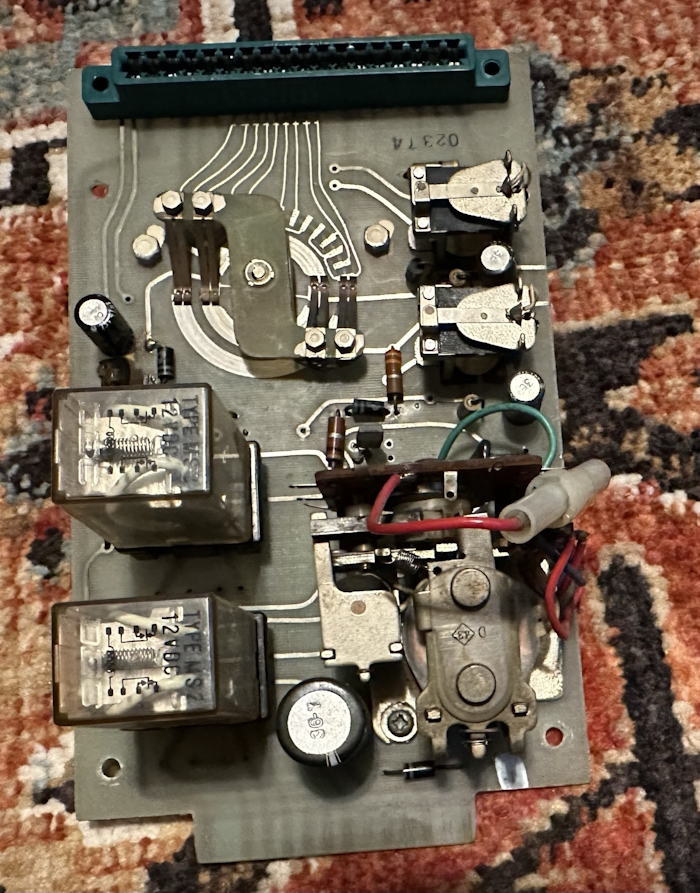
Behold, what I’ve been calling the search mechanism. This little board contains two relays, a stepper mechanism on the front, and a small motor on the back. It is delightfully electro-mechanical, proving that this is indeed an early arrangeball model, likely sometime between 73-75. The use of the Satomi name also seems to imply this.
It’s also where my problems likely lie. There are, as I see it, two options:
- Try to repair this board. Trace out the connections, and test the components one at a time.
- Replace the board with modern logic; likely a single arduino is enough. Hopefully, with minimal change to the rest.
Strategy forward
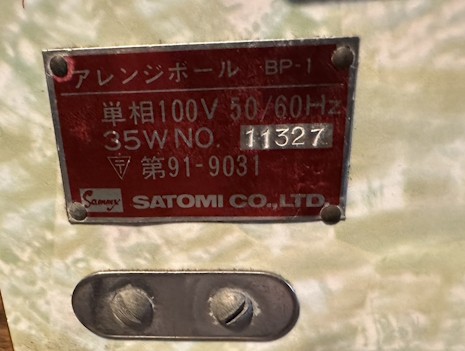
So, I think I’m going to try to repair this in its original way. That’s going to mean that I’m going to get familiar with its analog logic; hopefully, you all find that interesting and come along. On the way, I’ll trace things out, so that if I need to give in and make a new board, I’ll at least know how it should work.
This is probably going to be a pretty large undertaking for me, since it’s a lot of skills I’m not really familiar with. So please wish me the best of luck, and let me know if you have any resources that might be helpful! This is a pretty fun machine even in its broken state; I’m eager to get it up and running again.
